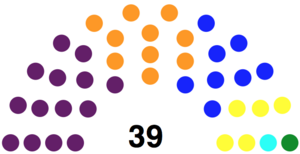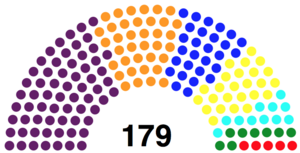Vinalian Parliament
This article is incomplete because it is pending further input from participants, or it is a work-in-progress by one author. Please comment on this article's talk page to share your input, comments and questions. Note: To contribute to this article, you may need to seek help from the author(s) of this page. |
Senate of the Union | |
|---|---|
| Сенат Союзу (Senat Soyuzu) | |
| Type | |
| Type | Upper House of the Vinalian Senate |
| Leadership | |
President | |
Vice President | Rayisa Bohdanivna, Unionist Party |
| Structure | |
| Seats | 39 |
 | |
Political groups | Government (32)
Opposition (7)
|
Length of term | 2 years |
| Elections | |
| Proportional representation | |
Last election | 18 January 2020 |
Next election | 18 January 2022 |
| Meeting place | |
| East Wing of the Vinalian Parliment Vinalinsk | |
| Website | |
| VSU.org.VN | |
House of the People | |
|---|---|
| Будинок народу (Budynok Narodu) | |
| Type | |
| Type | Lower House of the Vinalian House |
| Leadership | |
Minister-President | |
Vice President | Petro Voloshchuk, Workers Party |
| Structure | |
| Seats | 179 |
 | |
Political groups | Government (130)
Opposition (7)
|
Length of term | 2 years |
| Elections | |
| Proportional representation | |
Last election | 18 January 2020 |
Next election | 18 January 2022 |
| Meeting place | |
| West Wing of the Vinalian Parliment Vinalinsk | |
| Website | |
| VHP.org.VN | |
Vinalia is a federal, parlimentary, representative republic. Made up of the two constituent states of North and South Vinalia. Federal legislative power is vested on the Vinalian Parliament made up of the Senate of the Union (Upper House), and the House of the People (Lower House). The Senate picks the President, while the House picks the Minister-President
The multilateral system has, since 1993, been dominated by the Unionist Party, Conservative Party, and Workers Party,. The judiciary of Vinalia is independent of the executive and the legislature, while it is common for leading members of the executive to be members of the legislature as well. The political system is laid out in the 1993 constitution, the Tsyvilʹne Pravo (Civil Law), has been mantained since the year 1993, as established in the Treaty of Vinalian Reunification (TVR).
Electoral Process
Voters elect using the Proportional representation method, each province/federal district is divided into smaller ranges based on population, the division of the districts is based on the province or district with the lowest population (being Juyu Ruwach with 137,613.02 people). People vote first for parties based on their local district to the house, then elect by provincial level their 3 members. For parties to be entitled a seat in the house they must have earned 5% in their respective district